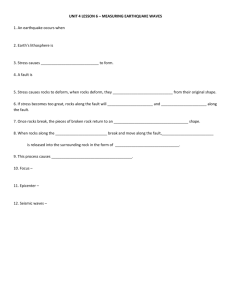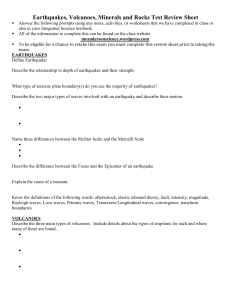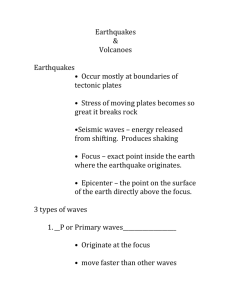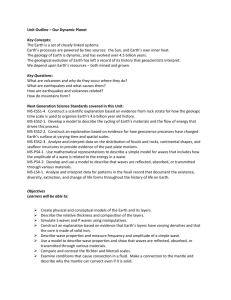Chapter 15
advertisement
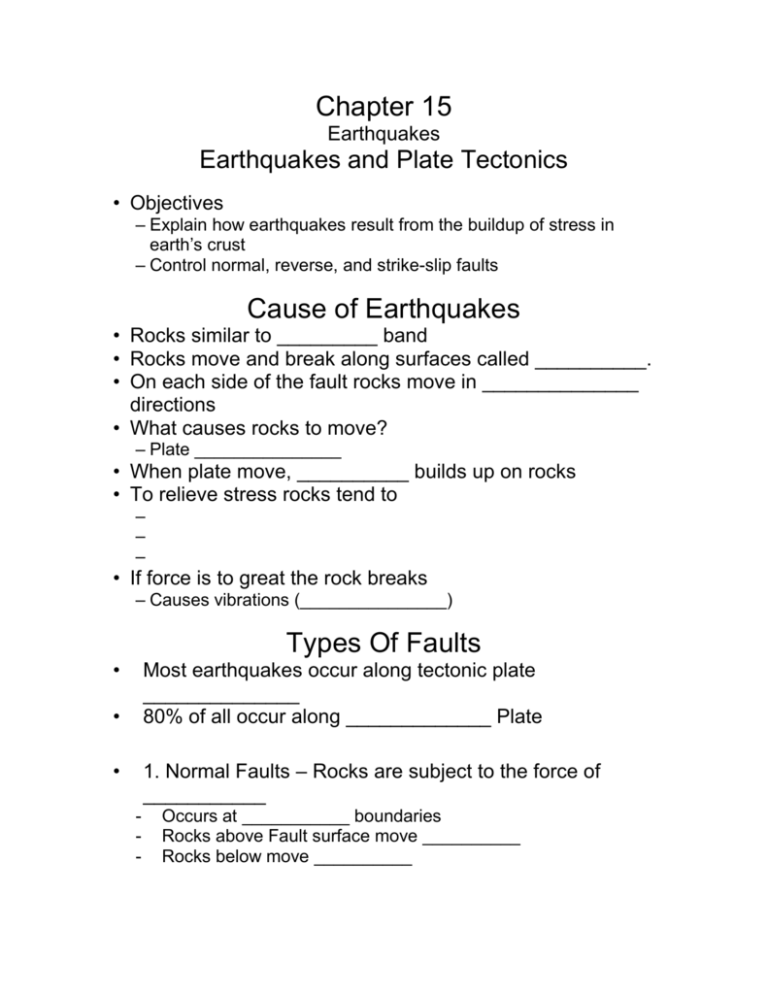
Chapter 15 Earthquakes Earthquakes and Plate Tectonics • Objectives – Explain how earthquakes result from the buildup of stress in earth’s crust – Control normal, reverse, and strike-slip faults Cause of Earthquakes • Rocks similar to _________ band • Rocks move and break along surfaces called __________. • On each side of the fault rocks move in ______________ directions • What causes rocks to move? – Plate _______________ • When plate move, __________ builds up on rocks • To relieve stress rocks tend to – – – • If force is to great the rock breaks – Causes vibrations (_______________) Types Of Faults • Most earthquakes occur along tectonic plate ______________ 80% of all occur along _____________ Plate • • 1. Normal Faults – Rocks are subject to the force of ___________ - Occurs at ___________ boundaries Rocks above Fault surface move __________ Rocks below move __________ - Theses types of faults occurred during the formation of the _________________ 2. Reverse Fault - ___________________ forces are applied - Rocks above fault surface are forced ______ - Rocks below are forced __________ -Generated at a ______________ boundary - ________________ Mountains contain many reverse faults 3. Strike-Slip Fault - ______________ Fault -Each plate sliding __________ one another -Subject to _____________ forces - Rocks moving in different but not opposite directions - Most famous _______________ Fault - North American Plate and Pacific Plate Seismic waves • Generated by an earthquakes ____________ • Moves ____________ from the focus • Three types of waves • 1. Primary - Cause rock particles to move ____________ and fourth Move the ___________ Slow down when they reach asthenosphere Slowed but can travel through the liquid outer core 2. Secondary - rock particles move at ____________ angles - ____________ then primary waves - Cannot travel through ______________ - cannot move through the ______________ core 3. Surface Waves - originates at the _________________ - gives particles _____________ motion - cause most of the _________________ - similar to waves in a___________ or in the ocean - are the _______________ of the three waves - Locating an Epicenter • Seismic Waves are measured at ________________ stations • Primary waves arrive _____________ • Secondary – ______________ • Surface – _________________ • The farther ____________ the waves the farther the epicenter is • ____ seismographs stations are needed to determine an epicenter • Distance btw. The station and the ___________ is determined • Scientist draw _________ around each station • Where the three circles _____________ is the epicenter Mapping the Interior of Earth • Moho’s discontinuity • Seismic waves speed up in the denser lithosphere Slow down in asthenosphere – Sped up in the solid lower mantle – Primary waves slowed down and deflected in the liquid outer core – Secondary waves is not transmitted through the outer core (Shadow Zone btw 105 -140 degrees) – Tsunami – Large giant Sea Wave cause by an underwater _____________________________ Measuring earthquakes 1. Seismograph—instrument that records an earthquake’s vibrations 2. If seismic-wave arrival times are recorded from three stations, the epicenter can be determined. 3. Richter scale—measures an earthquake’s size, or magnitude, based on the heights of lines representing the amount of energy released through seismic waves recorded on a seismograph (based on a tenfold) Content Outline for Teaching Earthquake Damage 1. Modified Mercalli intensity scale—measures an earthquake’s intensity based on the amount of structural and geologic damage 2. Most earthquake damage is caused by surface waves. 3. Tsunamis—when an earthquake occurs on the ocean floor, the sudden movement pushes against the water and creates powerful waves that can travel thousands of kilometers. Seismic-safe structures are able to stand up against an earthquake’s vibrations. 1. Many high-rise buildings stand on huge steel and rubber springs. 2. Underground water and gas pipes are replaced with pipes that will bend. 3. Highways have cement pillars with spiral reinforcing rods around them. F. Predicting Earthquakes 1. Long-range forecasts predict whether an earthquake is likely to occur in a given area within 30 to 100 years. Earthquakes and Volcanoes (continued) 15 15 Discussion Question What can you do to make your home more seismic-safe? Volcanoes Volcanoes and Plate tectonics Volcano is a mountain formed when layers of _______ and volcanic _________ erupt and build up Most are ____________ About __________ are active What cause Volcanoes Magma is less ____________ then solid rock It slowly rises to the earths ___________ Flows out through an opening called a ___________ Lava cools quickly and forms _____________ rock Opening at the top of the vent is called a ___________ Pyroclastic flow – massive _____________ of hot glowing rock and gases (complete destruction) Where do Volcanoes Form 1. Divergent Boundaries Mid __________________ Forms long deep cracks called ___________ where magma flows from 2. Convergent boundaries ________________Mt. Range in Oregon and Washington Mt. Saint ___________ ____________________ 3. Hot Spots ____________________ Far from the ____________ of any plate Some area of the mantle are ___________ then others These hot spots __________ rock which rise to the surface to form volcanoes Once the volcano rises above the water it becomes an ______________ What determines how a volcano Erupts _____________of the magma plays a big role in determining the manner in how a volcano erupts Lave – more ____________ (silicon and oxygen) tend to be thicker and resists flow Lava containing more ___________ and magnesium and less silica tend to flow easier Amount of water __________ in lava influences how lava erupts More water (steam) the more _____________ builds up and the more violent the eruption is Forms of Volcanoes Three basic volcanoes ____________________ ____________________ ____________________ 1. Shield ___________ eruption ____________ volcanoes ____________sloping sides Ex. Hawaiian, rift zones like Iceland 2. Cinder Cone _________________ Volcano Throws lava into the air, lava cools and hardens Tephra – small- _________ large – ___________ Forms ____________ sides Sunset crater 3. Composite Volcano Can vary between _____________ or violent Alternating layers of __________ and _____________ Convergent boundaries above ________________ zone Mt. St. Helens Fissure Eruption Magma that is highly fluid can ooze from _____________ or fissures in earths surface


